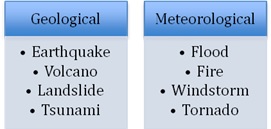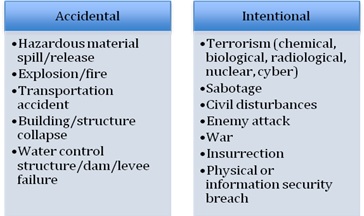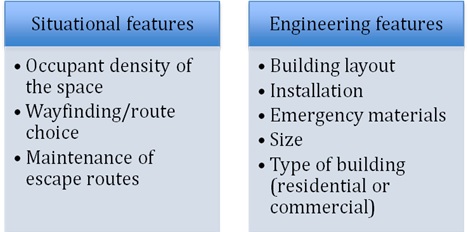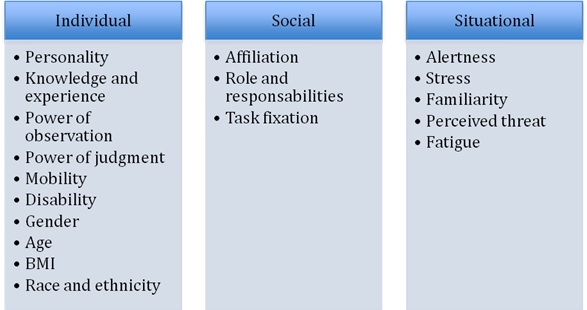Factors in evacuation response: an integrative model
Factors in evacuation response: an integrative model
The hazard response performance depends not only on human actions. A recent review about human behavior in emergencies, in particular in fire situations, attests that it mainly derives from 3 factors: danger factor, human factor and environmental factor (Kobes et al., 2010).
The danger factor refers to the characteristics and type of the hazard. The hazard may be due to: nature (see Figure 3) or human being (see Figure 4). In particular, Kobes and colleagues (2010) have focused their attention on fire characteristics, dividing them in: perceptual feature (elements which can be seen, smelt or heard that influence the time it take to discover the fire), fire growth rate and heat, smoke yield and toxicity. For other type of hazards characteristics will be different but always present. For example, earthquake could cause the falling of objects or part of the building that can obstruct the escape route and delay the evacuation. Other type of disasters like tornados could cause problems to the light system delaying the evacuation process due to the lack of light. Moreover, it has to be taken into account that different precautionary and protective actions can be performed to face these different types of hazards and people perceive them differently (Slovic, 1987).

Figure 3 – Natural hazards

Figure 4 – Human hazards
The human factor is composed by individual features, social features and situational features (see Figure 5).
Individual features include: personality (Kobes et al., 2010), knowledge and experience (Gershon et al., 2007; Kobes et al., 2010; Kuligowski, 2008), powers of observation (Kobes et al., 2010), powers of judgment (Kobes et al., 2010), mobility (Kobes, et al., 2010; Shields & Proulx, 2000), disability (Boyce, Shields & Silcock,1999a, 1999b, 1999c; Proulx, 2002), gender (Boyce, Purser & Shields, 2011), age (Spearpoint & MacLennan, 2012), body mass index (Spearpoint & MacLennan, 2012), race and ethnicity (Fothergill, Maestas, & DeRouen Darlington, 1999).
With personality, Kobes and colleagues (2010) refer to the following dimensions: leader or follower, level of stress resistance and self-efficacy. They state that, in the event of fire, the majority of people adopt the role of a follower, waiting for others to act. Moreover, people differ in terms of level of stress resistance and this can affect the evacuation process because too much psychic stress can impair cognitive processes and delay the response. Finally, “selfefficacy influences the choices that people make, the effort that they put in, how long an action is persisted with if obstacles are encountered (and people fail) and feeling. This is related to Bandura’s Social Cognitive Theory” (Kobes et al., 2010, p. 6).
Observation is crucial to estimate the threat of danger validating the cue. People who have a pronounced power of observation and judgment is faster in perceiving the cue by seeing, hearing, smelling or feeling it and this will result in a faster interpretation and validation of the cue before starting evacuating (Kobes et al., 2010).
Age has a direct effect on the evacuation speed (Spearpoint & MacLennan, 2012). Indeed there are multiple functional limitations associated with ageing that affect walking capacity (Ayis, Ebrahim, Williams, Juni & Dieppe, 2007). A slower walking pace will result in a slower and less efficient evacuation. With a global population facing an increasing ageing problem, age is getting more and more a crucial aspect that can have a weight in calculating and predicting evacuation times. Ageing has also a consequence that has an effect on the evacuation performance: the increase in the risk of falling and the development of the fear of falling (Stel, Pluijm, Deeg, Smit, Bouter & Lips, 2003). This is because “functional limitations can directly predict the risk of falling and hence the lack of confidence that would be associated with reaching safety in an evacuation” (Spearpoint & MacLennan, 2012, p. 1677). Fear of falling increase the possibility of plug flows that can be very dangerous in the evacuation process because will results in higher evacuation times.
Also obesity affects walking capacity and have an effect on the speed of the evacuation performance (Spearpoint & MacLennan, 2012). Medical studies have shown that the degree of fat mass is directly linked with increases in musculoskeletal pain and arthritic conditions. These elements lead to several functional limitations and also affect walking speed. “The increase in obesity and thus body size also relates to a marked increase in the potential for plug flow where there is no room on the landings for people to rest. Group altruism can be a further cause of plug flow where an obese person may need help” (Spearpoint & MacLennan, 2012, p. 1682).
Both age and obesity affect occupants’ mobility, which can be considered as the capacity to move out of the building. As it is easy to understand, reduced mobility causes delays in evacuation (Kobes et al., 2010).
Gender can also play an important role in evacuation performance, such as when males give priority to women and children or staff guiding other occupants (Boyce, Purser & Shields, 2011).
Other individual characteristics that are involved in the response are race and ethnicity. The interesting review by Fothergill and colleagues (1999) divided the response to a natural hazard into several categories in order to clarify the difference between several racial and ethnic groups in the US. The hazard response is divided into: risk perception, preparedness, warning communication and response, physical impacts, psychological impacts, emergency response, recovery, reconstruction. For example, the authors report that Afro-Americans are more fatalist then Anglos (white Americans) regarding earthquakes, and feel that there is little or nothing one could do to protect against them. Moreover, Hispanics are more likely than the others ethnic groups to use social networks for disaster information and they find mass media to be reliable more than Anglos and Afro-Americans. These are only some example from the review by Fothergill and colleagues (1999) that indicate how also aspects like race and ethnicity are relevant occupants’ characteristics that affect the hazard response.
Some studies have addressed the problem of elderly occupants or people with disabilities (Boyce, Shields & Silcock, 1999a, 1999b, 1999c; Proulx, 2002). Clearly these categories of occupants present specific characteristics that affect their mobility. The ideas that have been developed to solve this problem include the use of particular elevators or the creation of rooms in which they can shelter waiting for people to rescue them (Proulx, 2002).
Knowledge and experience are also important individual factors. Their contribution to the evacuation process will be explained in detailed in the next chapter of this literature review.
Social features incorporate: affiliation (Kobes et al., 2010), task fixation (Graham & Roberts, 2000) and role/responsibility (Boyce, Purser & Shields, 2011; Kobes et al., 2010).
Talking about affiliation, there are empirical evidences from studies investigating evacuation from residential buildings that family members respond as a group, often delaying the evacuation time (Kobes et al., 2010).
Other studies have pointed out that people engaged in tasks are inclined to first finish the job before performing other type of actions such as evacuating (Graham & Roberts, 2000).
Finally, what Kobes and colleagues (2010) report in their literature review is that “in the first instance people adhere to the role expectations appropriate to the function of the building where they are located […] Moreover, those who have organizational responsibilities for a building, by virtue of their roles or positions, such as waitresses and deportment managers, are also inclined to assume these duties during an emergency situation.
Situational features comprise: alertness (Kobes et al., 2010; Shields & Proulx, 2000), familiarity with the layout (Benthorn & Frantzich, 1996; Kobes, et al., 2010; Shields & Proulx, 2000), stress, perceived threat, fatigue (Averill et al., 2007; Galea et al., 2008; Spearpoint & MacLennan, 2012).
Evacuation can be a really demanding task from the physical point of view in case of high buildings with lot of floors and stairs. People sometimes would need to take a rest because of fatigue, and this problem will increase in the future due to the growing of a sedentary lifestyle with people not used to physical efforts (Spearpoint & MacLennan, 2012). Breaks caused by fatigue will have a delay effect on the evacuation process that has to be taken into account.
Occupants that are familiar with a building know how to move within it because they use it daily. Usually they are also aware of the safety procedures and emergency plan. However, familiarity with the building doesn’t lead automatically to the knowledge about emergency plan. So familiarity can be considered as a facilitating factor for the likelihood of an efficient evacuation. Nevertheless it is not a sufficient indicator. It is well known that the preference of most occupants is to evacuate through the way they came in (Benthorn & Frantzich, 1996).
Alertness is described as “the involvement of people with the activities being carried out within the building, or their interaction with the other occupants of the building which can affect their awareness of other circumstances. For instance, if people are in bed and asleep, their response to a fire alarm is likely to be considerably delayed” (Shields & Proulx, 2000, p.99). Kobes and colleagues (2010) also underline that alertness could be reduced by the consumption of alcohol, drugs and narcotics.

Figure 5 – Human factors
The environmental factor is composed by situational features and engineered features (see Figure 6). It provides the primary conditions for the possibility of surviving a hazard.
Situational features comprise: occupant density of the space (Aguirre, 2005; Kobes et al., 2010), wayfinding/route choice (Kobes et al., 2010) and maintenance of escape routes (Kobes et al., 2010).
Occupation density refers to the number of people in a building. Previous researches have defined that there is a direct correlation between high occupation density and a high probability of fatalities in case of disasters (Aguirre, 2005; Kobes et al., 2010).
Way-finding has already been debated in the previous chapters of this paper. Here we will only add some environmental factors that can help the way-finding process: visual access, level of architectural differentiation, layout, familiarity, presence of signage and location marking (Kobes et al., 2010).
The last point is composed by the maintenance of the escape routes. As it easy to understand, keeping the escape routes free and practicable is a basic and necessary factor to obtain a successful evacuation (Kobes et al., 2010).
Engineered features include: building lay out (e. g. number of floors), its installations (e. g. stairs, evacuation lifts, sky bridges, refugee floors, emergency exit that automatically open), emergency materials, but also its size (e. g. high rise buildings) and the type of building (residential or commercial).
In case of evacuation from buildings, an important aspect is the high of the building. Buildings greater than 23 meters are considered as high-rise buildings. The research considers this type of building as a separate category and deals with them independently. Evacuating from them, indeed, is more complex and need more time, and new variables have to be analyzed (like the choice of stairs or elevators) so that strategies, procedures and egress models for simulating high-rise buildings evacuation scenario are usually different from the others (Gershon et al., 2007; Hassanain, 2009; Zmud, 2007). Scholars studying high-rise building evacuation focalize on elements like stairs (stairs design in general, number of stairs, stairs width and length, merging streams of occupants in the floor-stair interface), special evacuation lifts, sky bridges that can be used to evacuate people at a level different from the ground floor to reduce the vertical evacuation travel distance (only in case of fires) and refuge floors (only in case of fires) (Ronchi & Nilsson, 2013).
Design features change depending on the type of building: office occupancies are different from health care facilities and different from hotels or residential apartments. For example, “from a design perspective, office buildings have generally open concept floor plans, which cause a reduction of the possibility to contain the fire within a compartment […] Fire systems are generally well-maintained, and may include recorded voice messages and fire alarms” (Ronchi & Nilsson, 2013). In residential buildings people are familiar with the environment, while in hotels not.
Some facilitating characteristics in buildings are the presence of focal points or emergency exits that automatically open in case of emergency (Benthorn & Frantzich, 1996; Shileds & Proulx, 2000).

Figure 6 – Environmental factors
© – MANAGEMENT OF AN EMERGENCY EVACUATION: A LEADER’S PERSPECTIVE – Sara Colangeli

